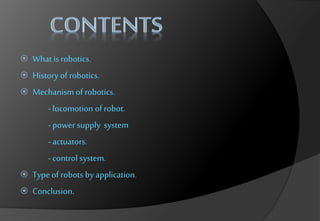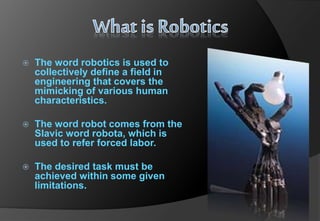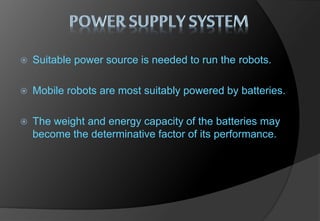Robotics
- 1. Presentationon PRESENTED BY MD.HASIBUR RAHMAN TOMAL ABU HANIF RAHIL MD AL-AMIN ARIF
- 2. What is robotics. History of robotics. Mechanism of robotics. -locomotion of robot. -power supply system -actuators. -control system. Type of robots by application. Conclusion.
- 3. The word robotics is used to collectively define a field in engineering that covers the mimicking of various human characteristics. The word robot comes from the Slavic word robota, which is used to refer forced labor. The desired task must be achieved within some given limitations.
- 4. The word robotics was derived from the word robot, which was introduced to the public by Czech writer Karel Capek in his play R.U.R. (Rossm’s Universal Robots), which premiered in 1921. The play begins in a factory that makes artificial people called robots
- 5. The first digitally operated and programmable robot, the Unimate, was installed in 1961 to lift hot pieces of metal from a die casting machine and stack them. Fully autonomous robots only appeared in the second half of the 20th century.
- 6. As the name suggests a robot must have a system to make it move. This system gives our machine the ability to move forward, backward and take turns. It may also provide for climbing up and down.
- 7. The concept of locomotion invariably needs rotational motion e.g. a wheel driven by some power source. This involves conversion of electrical energy into mechanical energy, which we can easily achieve using electrical motors. The issue is to control these motors to give the required speed and torque.
- 8. Suitable power source is needed to run the robots. Mobile robots are most suitably powered by batteries. The weight and energy capacity of the batteries may become the determinative factor of its performance.
- 9. They convert the electrical energy into meaningful mechanical work. Mechanical output can be rotational or linear (straight line). Motors provide rotational motion. Electromagnets provide linear motion
- 10. Controlling the current by passing it through a variable resistor is not advisable as it is extremely energy inefficient. A trick is done to achieve reduced average power. Power is supplied to the motor in short intermittent bursts, as explained further
- 11. Nowadays, robots do a lot of different tasks in many fields and the number of jobs entrusted to robots is growing steadily. That's why in my opinion one of the best ways how to divide robots into types is a division by their application. There are :- -- industrial robot -- medical robot -- military robot -- service robot -- space robot
- 12. Industrial robots - Industrial robots are robots used in an industrial manufacturing environment. Usually these are articulated arms specifically developed for such applications as welding, material handling, painting and others. If we judge purely by application this type could also include some automated guided vehicles and other robots
- 13. Medical robots - Robots used in medicine and medical institutions. First and foremost - surgery robots. Also, some automated guided vehicles and maybe lifting aides. There seems to be high risk of difficulties in most of the surgeries and some times there are chances for mortality. Hence, most of the scientists and doctors made various researches in order to make the surgeries safe and secure. In such situations, robots can help a lot in making the surgery more safer since they could make smaller cuts in the organs or tissues. This would in turn make the patients feel easier and comfortable.
- 14. Military robots - Robots used in military. This type of robots includes bomb disposal robots, different transportation robots, reconnaissance drones. Often robots initially created for military purposes can be used in law enforcement, search and rescue and other related fields
- 15. Entertainment robots - These are robots used for entertainment. This is a very broad category. It starts with toy robots such as robosapien or the running alarm clock and ends with real heavyweights such as articulated robot arms used as motion simulators
- 16. Space robots - I’d like to single out robots used in space as a separate type. This type would include robots used on the International Space Station, Canadarm that was used in Shuttles, as well as Mars rovers and other robots used in space
- 17. Today we find most robots working for people in industries, factories, warehouses, and laboratories. Robots are useful in many ways. For instance, it boosts economy because businesses need to be efficient to keep up with the industry competition. Therefore, having robots helps business owners to be competitive, because robots can do jobs better and faster than humans can, e.g. robot can built, assemble a car. Yet robots cannot perform every job; today robots roles include assisting research and industry. Finally, as the technology improves, there will be new ways to use robots which will bring new hopes and new potentials


















